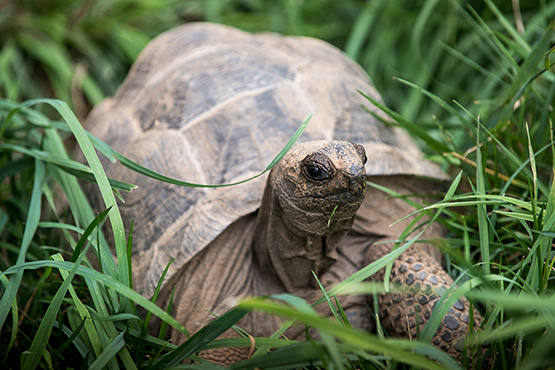Aldabra Tortoise
[Geochelone gigantea]
Share:
Quick Facts
Size: Females grow a shell up to 3 feet in length and can weigh up to 350 pounds. Males can grow a shell up to 4 feet in length and weigh up to 550 pounds.
Lifespan: Over 100 years.
Color: Dark gray to black on their skin and shell.
Continent: The islands of Aldabra in the Indian Ocean.
Range: Restricted to the Aldabra Atoll (a small chain of coral islands)
The Aldabra tortoise is one of the largest tortoises, second only to the Galapagos tortoise. In their quest for nutritious vegetation, these large grazers knock over plants, shrubs, and even small trees, clearing pathways for other animals to use.

Aldabra tortoises are one of the longest-living animals. Their lifespan, however, is just speculation as these tortoises have so far outlived every scientists that has studied them and in the past poor records were kept about individual ages.
Aldabra tortoises breed from February to May. The female tortoise will carry the eggs for ten weeks before finding a place for a nest, digging a hole up to ten inches deep. Eggs are the size of tennis balls and a clutch can be from four to 25 eggs. After laying her clutch in the well-hidden nest, the female leaves the eggs to incubate for an average of four months. In low-density population areas, a female tortoise may lay more eggs and nest twice in one season. Many of the laid eggs, sometimes up to half, may be infertile.
The Aldabra is the only remaining species of giant tortoises once found on Madagascar and the Seychelles Islands. One of the first species to be protected for the purpose of ensuring their species survival, Charles Darwin and other notable conservationists created a captive breeding population on the island of Mauritius, and the Seychelles government began protection of the Aldabra Atoll.
Location in the Zoo: The Islands
Schedule: Out on exhibit during warm seasons, typically between Memorial Day weekend and Labor Day.
